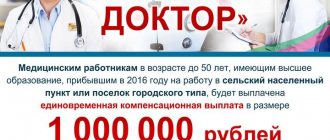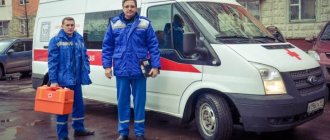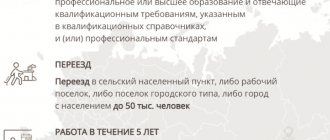Residents of all regions and far corners of the country need periodic medical examinations and the opportunity to seek emergency help. However, young specialists and highly qualified staff of clinics tend to move to big cities; few people are satisfied with life in villages and villages. In order to somehow solve this problem, the Government has developed the state program “Zemsky Paramedic”, which involves paying large sums of money to medical personnel who are ready to move to urban settlements, workers’ settlements and small towns in Russia to carry out work activities in them. This project is an addition to the “Zemsky Doctor” program - it is also very relevant given the fact that honey. institutions need not only doctors with higher education, but also mid-level medical personnel. Let’s figure out what the conditions of the “Zemstvo Paramedic” program are in the regions in 2021, and what changes have recently been made to the provisions of the state program.
State program “Zemstvo Paramedic”: basic information
The “Zemstvo Paramedic” program was developed by the Federal Government, however, it is considered regional on the grounds that the project operates only on the territory of constituent entities whose authorities note an urgent need for mid-level medical personnel and are ready to implement the program in order to attract new employees.
The purpose of financing the program is to provide high-quality and timely medical care to residents of every region of Russia , including sparsely populated and remote settlements. The authorities are thereby trying to equalize the rights of urban and rural residents to access to medical services.
Moreover, the following most important tasks of the authorities are simultaneously solved:
- young people are attracted to work in rural medical institutions, and thereby the workforce is rejuvenated;
- the living conditions of medical workers are being improved or pressing housing problems of medical personnel are being resolved;
- The authority of the position of paramedic in the village increases.
The program is already bringing significant benefits to Russians, therefore:
- The Russian government is discussing the possibility of extending the Zemsky Paramedic project until 2021;
- in the current year 2021, it is planned to increase the number of grant recipients by one and a half times.
“This is a very big help. For example, I would still come to work at this medical center, because I wanted to realize myself in the profession of a paramedic. And the grant funds allowed me to close my mortgage. I come from the capital, studied at Kazan Medical College. At first everyone was shocked, they say, how is it that she lived in the city all her life, but moved to the village and went to work in the village. The first aid station here was built in 2015, but currently the equipment has not even been used. The fact is that the building was empty, there was no one to work. Once a week, medical workers from the city came and made door-to-door visits without using the medical post premises. And now, thanks to the “Zemsky Paramedic” program, there is someone to work in the village (by the way, a doctor appeared here thanks to participation in the “Zemsky Doctor” program), and more than 400 patient residents of the village are seen 6 days a week. It’s good for the population, and it’s good for the specialist with the money.”
Aigul Mindubaeva, participant of the “Zemsky Paramedic” program (Ozersky village, Vysokogorsky district, Tatarstan)
How to get involved?
However, statistics show that over the past four years, a million has forced only about 4 thousand young professionals to move to the outback. Why is the Zemsky Doctor program not working at full capacity? The main reason is the lack of necessary equipment and basic medicines to treat patients. Simply put, for the allocated million you have to buy both a stethoscope and brilliant green with bandages. The unsightly picture is complemented by low salaries and difficult living conditions (a million is no longer enough to install water supply and sewerage in a private house). It is surprising that the allocated billions last year were only partially spent. This confirms that the problem is not in financing, but in the way the system operates.
Answers to basic questions
At the end of 2011, the law “On Amendments to the Federal Law “On Compulsory Health Insurance in the Russian Federation” was adopted, which detailed some aspects of the stages of implementation of the program aimed at stimulating the influx of medical workers with higher education to work in the Russian village.
The regional cabinet of ministers has made changes to the procedure for providing one-time compensation payments to employees. In particular, for doctors and paramedics who come to work in rural settlements or workers' settlements located in remote and hard-to-reach areas, the amount of payments increases to 1.5 and 0.75 million rubles, respectively. Previously, payments were 1 and 0.5 million rubles. Payments are made on the basis of co-financing from the federal and regional budgets. We are talking about doctors who are ready to find employment in hospitals and first-aid posts at a distance of over 100 kilometers from the regional center.
You may be interested in:: Benefits for labor veterans in the Murmansk region in 2021
The new measures are designed to improve the situation with the availability of medical care in remote areas. “ We expect to attract new medical personnel, which we really lack in the villages. We need at least 181 people in FAPs. Today we provide medical care in remote areas on a mobile basis, but we are obliged to provide populated areas with permanent medical workers. We hope that this measure will allow us to increase the number of workers during this year and ensure the quality and availability of medical care ,” said Dmitry Vyushkov, Minister of Health of the Omsk Region.
- age less than 35 years;
- training was conducted at the full-time budget department;
- in hand a diploma of education;
- official work activity in the first year after defending the diploma;
- The first job is based on the specialization received at an educational institution.
State program “Zemstvo paramedic”: latest news
Previously, the state program “Zemstvo Paramedic” allowed paramedics under the age of 50 to receive a one-time incentive payment if they were willing to move to small settlements to work in local medical institutions.
Recently (after the entry into force of the Government of the Russian Federation Decree No. 1347 of October 18, 2021), the right to receive payment in case of employment in villages, small towns and PGS also arose for paramedics whose age exceeds 50 years. The size of the remuneration remains the same.
What benefits are approved for paramedics working in rural areas?
- Additional leave (paid) added to the main annual one:
- 35 days if the health worker works in a psychoneurological dispensary;
- 21 days if the employee is a radiologist;
- 14 days if the health worker works in a tuberculosis clinic or department for the treatment of AIDS patients.
- Work on a reduced working day or week (from 24 to 36 hours, depending on the paramedic’s availability).
- Providing free special meals (if the paramedic works in the surgery department, intensive care unit or x-ray room).
- Medical services at the place of work, paid for by the employer.
What are the housing and utility benefits for paramedics?
Comment: Young specialists can also claim benefits for paramedics, provided that they have received a state diploma and that they got a job within a year after receiving the education document.
Hospital doctors are entitled to 3,880 rubles for one standard shift, and nursing and junior hospital staff are entitled to 2,430 rubles. and 1215 rub. respectively. For health workers providing medical care on an outpatient basis, doctors will be paid 2,430 rubles per standard shift, nursing staff will be paid 1,215 rubles, and junior medical staff will be paid 600 rubles. Payments are also provided for employees of pathology bureaus.
Special monthly social payments will be paid to medical and other employees of medical organizations providing medical assistance in the diagnosis and treatment of COVID-19 for the period from November 1, 2021 to December 31, 2021. Their size will be determined depending on the position, the nature of work in one standard shift, which represents 1/5 of the working hours per week established for the corresponding category of employee (Resolution of the Government of the Russian Federation of October 30, 2021 No. 1762). These special social payments will replace incentive payments to health workers, which were provided until October inclusive.
Now, for one standard shift, the following payment amounts have been established: for emergency doctors - 2430 rubles, paramedical ambulance staff - 1215 rubles, junior ambulance staff - 950 rubles, paramedics for receiving ambulance calls - 600 rubles, drivers of mobile vehicles ambulance teams - 1215 rubles.
- employees of outpatient CT centers and city clinics who identify sick people and provide medical supervision at home: 70 thousand rubles - for doctors, 50 thousand rubles - for paramedical personnel;
Previously, financial incentives were established for hospital workers providing medical care to patients with COVID-19 in the amount of 70 thousand rubles for doctors, 50 thousand rubles for nursing staff and 30 thousand rubles for junior medical staff and other employees.
- employees of laboratories of medical organizations conducting research of biological materials, as well as employees of pathology departments: 70 thousand rubles - for doctors, 50 thousand rubles - for nursing staff and 30 thousand rubles - for junior medical staff and other employees.
Not only employees of government agencies, but also private clinics can receive cash rewards for working with coronavirus patients. Additional payments are also provided to pathologists working with COVID-19 and to health workers with higher non-medical education, for example, biologists from clinical laboratories.
You may like => What is the cost of living per person in the twentieth year in January, the city of Kirov
If doctors working in ambulances become infected with coronavirus, they can count on additional insurance. If they go on sick leave with such a diagnosis, they will receive a one-time payment in the amount of 68,811 rubles.
Regional allowances
Health workers will receive payments from November 2021. Their size depends on the position and nature of the work. Thus, for one standard shift, the allowance for ambulance doctors is 2,430 rubles, 1,215 rubles for paramedics and drivers, 950 rubles for junior medical staff and 600 rubles for paramedics who receive calls.
All federal payments to doctors fighting coronavirus are completely exempt from personal income tax, that is, they are paid in full, without tax deductions. Moreover, at the president’s proposal, allowances must be taken into account when calculating vacation pay or compensation for unused vacation.
The first document provides for payments “for special working conditions and additional workload” to health workers providing medical care to citizens with confirmed coronavirus infection, or working with biologically infected material.
The topic of payments to medical staff was discussed at a meeting of Russian President Vladimir Putin with members of the government. Following the discussion, the head of state noted that additional payments to doctors should be maintained at least until the end of the year. At the same time, in October the rules for calculating payments will not change, and from November their size will depend on the actual time worked.
- patients with confirmed coronavirus infection;
- patients with community-acquired pneumonia or signs of acute acute respiratory viral infections;
- patients with suspected COVID-19 who are being treated at home;
- in serving patients and personnel who have risks of infection in the workplace (employees of emergency departments, X-ray rooms, cafeterias, canteens, cleaners, wardrobe maids, etc.).
These amounts are divided by the planned number of shifts per month per rate, and then multiplied by the number of shifts actually worked, during which at least one patient of the above categories was provided with assistance. The number of shifts is set at the medical institution based on the monthly working hours.
The above amounts should be divided by the planned number of shifts per month per pay rate, and then multiplied by the number of shifts actually worked during which the health worker provided care to at least one patient infected with COVID-19. The number of shifts is established in a medical institution depending on the monthly working hours for the corresponding category of health workers.
The innovation will change the procedure for remuneration; it is not an addition to the existing system, but an alternative to it, which should ensure a more equitable distribution of money. The bottom line is that now the additional payment will be calculated based on the standard shifts actually worked (1 shift is equal to a fifth of the working time for the week). That is, only those shifts during which employees had contact with coronavirus patients will be taken into account.
Who is eligible to take part in the program (what are the conditions of the “Zemsky Paramedic” program)
Important! A medical worker who decides to take part in the state program is required to sign an agreement with the health department and the medical organization at the new place of employment. The duration of the contract must be at least 5 years (this period does not include the time spent on parental leave for up to one and a half, three years or more).
A contract with a candidate for participation in the state program can be concluded only if the following requirements are met:
| No. | Mandatory requirement for program participants | Clarification |
| 1 | Compliance of the participant’s age with the stated requirements | Federal authorities have officially increased the age of applicants for participation in the program. However, in some regions, authorities still require candidates to be no older than 50 years old (sometimes 35-45 years old). |
| 2 | Completed medical education (in secondary vocational educational institutions) | Having a state diploma with a mark on the acquired specialty of a paramedic is required to participate in the program. |
| 3 | Residence in the territory of the selected locality at the place of employment (in the region participating in the project) | For the entire duration of the contract, the paramedic is required to reside permanently in a village, urban settlement, sparsely populated city or in a workers’ settlement with which the medical worker has entered into an employment agreement. |
| 4 | Mandatory completion of the prescribed period | Contracts with paramedics who received a grant are concluded for a period of 5 years. During this period, the paramedic must work full time. |
Previously, it was also necessary to meet the age established by the program. In 2021, the age limit for a participant was 45 years. Then in most regions it was increased to 50 years. However, until now, the authorities of individual regions require candidates to apply for participation in the program only if they are under 35 years of age (in such regions, rejuvenation of the staff is a particularly important task).
Important! The final list of conditions for participation in the “Zemstvo Paramedic” program can be clarified with the authorities of the selected region, since the board of constituent entities of the Russian Federation has the right to adjust the conditions depending on the situation with medical personnel in the region under their jurisdiction.





